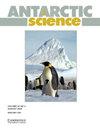南极半岛东北部大陆架麻子的形态
IF 2
4区 地球科学
Q3 ENVIRONMENTAL SCIENCES
引用次数: 2
摘要
摘要麻点是海底凹陷,当气体或液体从下层沉积物中逸出时形成。尽管麻点是冰川大陆架和低纬度大陆架的共同特征,但此前南极半岛东北部边缘还没有麻点的报道。在这里,我们使用自动水下航行器获得的高分辨率地球物理数据绘制了南极半岛东北部陆架三个位置的240多个麻点。麻点宽度为0.4~45m,深度为0.1~2.5m,包括较小的单位麻点和较大的正常麻点。我们数据的高分辨率使我们能够识别与麻点相关的减弱特征,包括水柱内的声学耀斑、喷出物边缘、麻点内区块,甚至可能是生物结构。冰下和冰缘地貌被麻点叠加,将其形成时间限制在最后~11 ka。调查区域内的高密度麻点,加上天然气主动渗入海底的地球物理证据,表明地下流体的排出是南极半岛东北部陆架的一个广泛过程,可能对海底生物多样性和全球碳循环产生重要影响。本文章由计算机程序翻译,如有差异,请以英文原文为准。
The morphology of pockmarks on the north-east Antarctic Peninsula continental shelf
Abstract Pockmarks are sea-floor depressions that form when gas or liquid escapes from underlying sediments. Although they are a common feature of both glaciated and lower-latitude continental shelves, pockmarks have not been reported previously from the north-east Antarctic Peninsula margin. Here we use high-resolution geophysical data acquired using autonomous underwater vehicles to map > 240 pockmarks in three locations along the north-east Antarctic Peninsula shelf. The pockmarks are 0.4–45 m wide and 0.1–2.5 m deep, encompassing both smaller unit-pockmarks and larger normal-pockmarks. The high resolution of our data enables the identification of subdued features associated with the pockmarks, including acoustic flares within the water column, ejecta rims, intra-pockmark blocks and possibly even biological structures. The overprinting of subglacial and ice-marginal landforms by the pockmarks constrains their timing of formation to the last ~11 ka. The high density of pockmarks within the surveyed areas, together with geophysical evidence for the active seepage of gas to the sea floor, suggests that the expulsion of subsurface fluids is a widespread process on the north-east Antarctic Peninsula shelf that could have important implications for benthic biodiversity and the global carbon cycle.
求助全文
通过发布文献求助,成功后即可免费获取论文全文。
去求助
来源期刊

Antarctic Science
地学-地球科学综合
CiteScore
3.60
自引率
6.20%
发文量
42
审稿时长
3 months
期刊介绍:
Antarctic Science provides a truly international forum for the broad spread of studies that increasingly characterise scientific research in the Antarctic. Whilst emphasising interdisciplinary work, the journal publishes papers from environmental management to biodiversity, from volcanoes to icebergs, and from oceanography to the upper atmosphere. No other journal covers such a wide range of Antarctic scientific studies. The journal attracts papers from all countries currently undertaking Antarctic research. It publishes both review and data papers with no limits on length, two-page short notes on technical developments and recent discoveries, and book reviews. These, together with an editorial discussing broader aspects of science, provide a rich and varied mixture of items to interest researchers in all areas of science. There are no page charges, or charges for colour, to authors publishing in the Journal. One issue each year is normally devoted to a specific theme or papers from a major meeting.
 求助内容:
求助内容: 应助结果提醒方式:
应助结果提醒方式:


